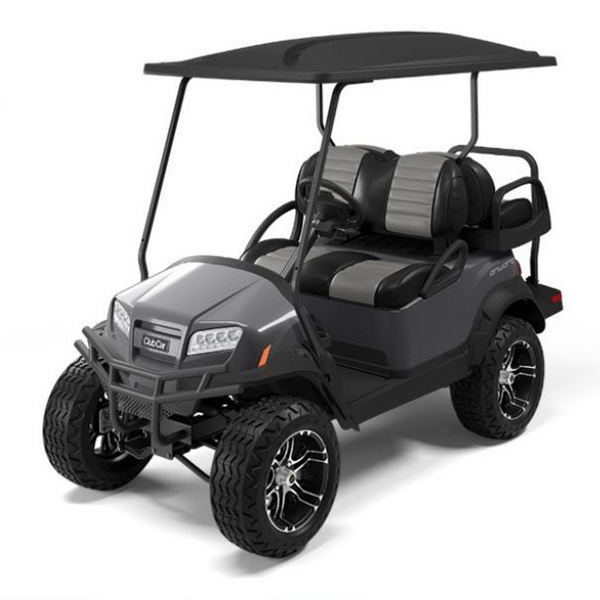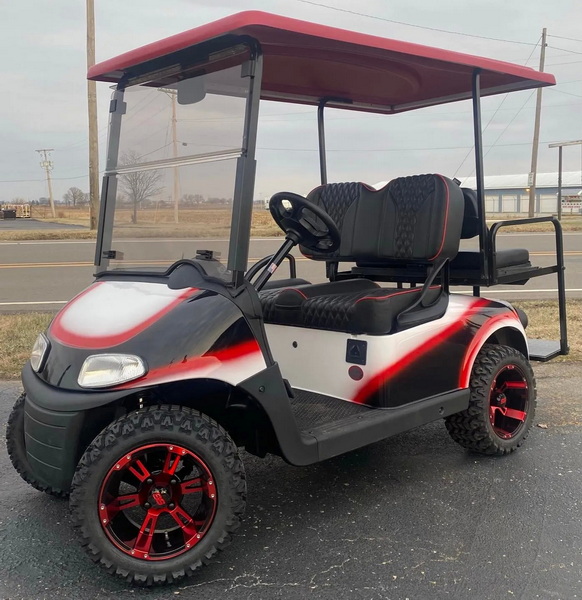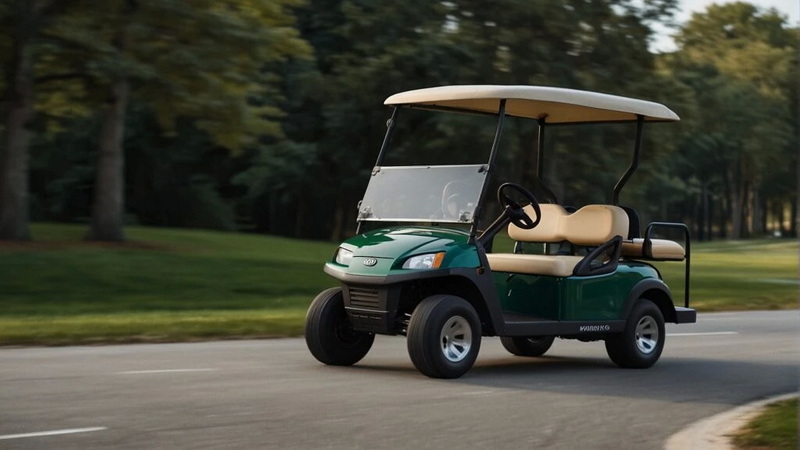Content Menu
● Understanding Horsepower in Electric Golf Carts
● Performance Characteristics of Electric Golf Carts
● Factors Affecting Horsepower and Performance
● Comparison with Gas-Powered Golf Carts
● Popular Electric Golf Cart Models
● Advantages of Electric Golf Carts
● Challenges Faced by Electric Golf Carts
● Future Trends in Electric Golf Carts
● Conclusion
● FAQ
>> 1. How long does an electric golf cart run on a full charge?
>> 2. Can I leave my electric golf cart plugged in all the time?
>> 3. What type of maintenance do electric golf carts require?
>> 4. Are there high-performance electric golf carts available?
>> 5. Can I modify my electric golf cart for more speed?
Electric golf carts have become increasingly popular for recreational use, especially on golf courses and in residential communities. One of the most common questions potential buyers ask is, "How much horsepower does an electric golf cart have?" Understanding the horsepower of electric golf carts can help you make an informed decision when purchasing one. This article will delve into the horsepower ratings of electric golf carts, their performance characteristics, and factors influencing their power.

Understanding Horsepower in Electric Golf Carts
Horsepower (HP) is a unit of measurement that indicates the power output of an engine or motor. In the context of electric golf carts, horsepower is derived from the electric motor's specifications.
- Typical Horsepower Range: Most electric golf carts feature motors that produce between 3 to 5 horsepower. This range is significantly lower than that of gas-powered golf carts, which can produce between 10 to 14 horsepower.
- Torque vs. Horsepower: While electric golf carts may have lower horsepower ratings, they often compensate with higher torque. Torque is crucial for acceleration and pulling power, making electric carts effective in various terrains despite their lower horsepower.
Performance Characteristics of Electric Golf Carts
Electric golf carts are designed primarily for smooth operation and efficiency rather than raw power. Here are some key performance characteristics:
- Speed: The top speed of most electric golf carts typically ranges from 12 to 25 mph, depending on the model and battery configuration. Higher-end models may reach speeds closer to 30 mph with modifications.
- Range: On a full charge, electric golf carts can travel between 18 to 40 miles, depending on factors such as battery capacity and terrain. Some advanced models equipped with larger batteries can exceed this range.
- Acceleration: Electric motors provide instant torque, allowing for quick acceleration from a standstill, which can be advantageous in hilly areas or when starting from a stop. This characteristic makes them ideal for navigating uneven terrains commonly found on golf courses.
- Maintenance: Electric golf carts require less maintenance than gas-powered models since they have fewer moving parts and do not require oil changes. Regular checks on battery health and connections are typically sufficient to keep them running smoothly.
Factors Affecting Horsepower and Performance
Several factors can influence the performance and effective horsepower of an electric golf cart:
- Motor Type: The type of motor (AC vs. DC) can affect performance. AC motors generally provide better efficiency and higher torque compared to DC motors. Many newer models are transitioning to AC motors due to their advantages in performance.
- Battery Voltage: Higher voltage systems (like 48V) typically deliver more power and torque than lower voltage systems (like 36V). This increased voltage allows for better performance in terms of speed and hill-climbing capabilities.
- Weight Capacity: The weight being carried by the cart can also impact its performance. Heavier loads may reduce speed and acceleration, especially on inclines where additional torque is required.
- Terrain: The type of terrain affects how much power is needed. Steeper inclines or rough surfaces require more torque to maintain speed. Golf courses often have varied landscapes that can challenge even well-designed carts.
- Tire Size and Type: The size and type of tires can also affect how much power is needed to move the cart. Larger tires may require more power to turn but can provide better traction on rough terrain.

Comparison with Gas-Powered Golf Carts
To better understand the capabilities of electric golf carts, it's helpful to compare them with gas-powered models:
| Feature | Electric Golf Carts | Gas-Powered Golf Carts |
| Horsepower | 3 - 5 HP | 10 - 14 HP |
| Torque | Higher | Lower |
| Top Speed | 12 - 25 mph | 15 - 25 mph |
| Range | 18 - 40 miles | Varies (fuel-dependent) |
| Maintenance | Low | Moderate |
| Environmental Impact | Zero emissions | Emits pollutants |
Popular Electric Golf Cart Models
Several manufacturers offer electric golf carts with varying horsepower ratings and features:
- Club Car Precedent: Known for its reliability, this model typically has a motor producing around 3-5 HP, suitable for standard golfing needs. It features advanced technology for efficient battery management and smooth rides.
- Yamaha Drive2: Another popular choice among golfers, featuring similar horsepower ratings but with enhanced comfort and design. It includes a spacious interior and improved suspension for a smoother ride over uneven ground.
- E-Z-GO RXV: Offers a balance between performance and efficiency, also within the typical HP range for electric models. The RXV is known for its innovative technology that enhances battery life and overall performance.
Advantages of Electric Golf Carts
Electric golf carts come with several advantages that make them appealing choices for users:
- Environmental Benefits: With zero emissions during operation, electric golf carts contribute positively to reducing air pollution compared to gas-powered alternatives.
- Quiet Operation: Electric motors operate quietly, making them ideal for use on golf courses where noise restrictions may apply.
- Cost Efficiency: Over time, electric golf carts tend to be more cost-effective due to lower fuel costs (electricity vs. gasoline) and reduced maintenance expenses.
- Customization Options: Many manufacturers offer customization options for electric golf carts, allowing users to choose features like upgraded batteries, enhanced seating, or additional storage solutions.
Challenges Faced by Electric Golf Carts
Despite their many advantages, electric golf carts do face certain challenges:
- Battery Life Concerns: Battery degradation over time can lead to reduced range and performance if not properly maintained or replaced when necessary.
- Charging Infrastructure: Depending on location, access to charging stations may be limited, which can pose challenges for longer trips or extended use away from home bases.
- Initial Cost: The upfront cost of purchasing an electric golf cart can be higher than that of gas-powered models due to advanced technology used in batteries and motors.
Future Trends in Electric Golf Carts
As technology continues to advance, several trends are emerging in the world of electric golf carts:
- Improved Battery Technologies: Innovations in battery technology promise longer ranges and shorter charging times, making electric options more viable for various uses beyond just golfing.
- Smart Features: Many new models are incorporating smart technologies such as GPS navigation systems, Bluetooth connectivity, and mobile app integration for enhanced user experience.
- Sustainability Initiatives: As environmental concerns grow, manufacturers are focusing on sustainable production practices and materials to appeal to eco-conscious consumers.
Conclusion
In summary, electric golf carts typically possess a horsepower range of 3 to 5 HP, making them suitable for light-duty tasks such as transporting players around a golf course or within residential communities. Although they may lack the raw power of gas-powered models, their higher torque output allows for effective acceleration and handling on various terrains. When choosing an electric golf cart, consider factors like motor type, battery voltage, weight capacity, terrain conditions, and intended use to ensure you select a model that meets your needs effectively.

FAQ
1. How long does an electric golf cart run on a full charge?
Electric golf carts usually run for about 45 minutes to two hours, depending on battery condition and usage patterns.
2. Can I leave my electric golf cart plugged in all the time?
Yes, most modern chargers will stop charging once the batteries are full; however, it's best practice to unplug when fully charged to prolong battery life.
3. What type of maintenance do electric golf carts require?
Regular maintenance includes checking battery water levels, cleaning terminals, ensuring connections are tight, and inspecting tires regularly for wear.
4. Are there high-performance electric golf carts available?
Yes, some models feature powerful motors exceeding standard HP ratings providing enhanced speed and torque suitable for off-road conditions or hilly terrains.
5. Can I modify my electric golf cart for more speed?
Yes, upgrades such as higher voltage batteries or more powerful motors can increase speed but may affect warranty or safety standards; always consult with professionals before making modifications.










































